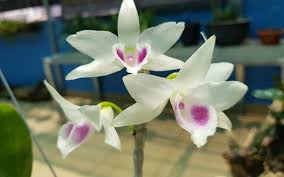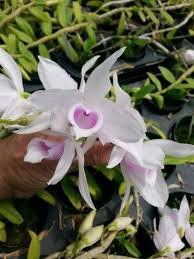
Phi Diep orchids (*Dendrobium anosmum*), renowned for their striking blooms and fragrant flowers, are a treasure in the world of horticulture. Their beauty and elegance make them a sought-after choice among orchid enthusiasts. However, cultivating these stunning plants requires the right tools and knowledge to ensure they thrive. This article will explore the essential tools necessary for the effective care of Phi Diep orchids, highlighting their functions and best practices for using them.
## 1. Understanding the Needs of Phi Diep Orchids
### 1.1 Overview of Phi Diep Orchids
Phi Diep orchids are native to Southeast Asia and are appreciated for their long-lasting flowers and unique growth habits. They are epiphytic plants, which means they grow on other plants in their natural habitat, absorbing moisture and nutrients from the air and rain. Understanding their specific requirements is crucial for successful cultivation.
### 1.2 Care Requirements
To effectively care for Phi Diep orchids, it’s important to address their needs:
– **Light:** They thrive in bright, indirect light.
– **Water:** Consistent moisture is essential, but overwatering can lead to root rot.
– **Humidity:** A humid environment helps them flourish, usually around 50-70%.
– **Temperature:** They prefer daytime temperatures between 65°F and 85°F (18°C – 29°C).
## 2. Essential Tools for Orchid Care
### 2.1 Basic Gardening Tools
1. **Pruning Shears**
– **Function:** Used for trimming dead or damaged leaves and stems, as well as for cutting back overgrown plants.
– **Best Practices:** Ensure they are sharp and clean to prevent disease transmission. Use them to prune at an angle to encourage healthy regrowth.
2. **Watering Can**
– **Function:** For delivering water directly to the orchid roots.
– **Best Practices:** Choose a can with a long spout for precision watering. Avoid watering in direct sunlight to prevent leaf burn.
3. **Spray Bottle**
– **Function:** Useful for misting orchids to increase humidity around them.
– **Best Practices:** Use distilled or rainwater to prevent mineral buildup on the leaves. Mist early in the day to allow moisture to evaporate.
4. **Garden Trowel**
– **Function:** Helpful for mixing potting media and transferring soil into pots.
– **Best Practices:** A small, hand-held trowel is best for working in small pots. Clean it regularly to avoid soilborne diseases.
### 2.2 Specialized Orchid Tools
1. **Orchid Potting Mix**
– **Function:** A well-draining potting medium is crucial for healthy roots.
– **Best Practices:** Use a mix of orchid bark, coconut coir, perlite, and charcoal. Repot every 1-2 years to refresh the medium.
2. **pH Meter**
– **Function:** Measures the acidity of the potting mix, ensuring it falls within the optimal range for orchids (5.5 to 6.5).
– **Best Practices:** Test the mix periodically, especially if you notice growth issues. Adjust pH by incorporating pine bark or other organic materials if necessary.
3. **Humidity Gauge (Hygrometer)**
– **Function:** Monitors humidity levels in the growing environment.
– **Best Practices:** Place it near your orchids to get accurate readings. Aim for humidity levels between 50-70%.
4. **Thermometer**
– **Function:** Measures temperature to ensure it remains within the ideal range for Phi Diep orchids.
– **Best Practices:** Place it in the growing area to monitor temperature fluctuations, especially during seasonal changes.
### 2.3 Propagation and Repotting Tools
1. **Rooting Hormone**
– **Function:** Encourages root development in cuttings or divisions.
– **Best Practices:** Dip the cut end of the orchid cutting into the hormone before planting to promote faster root growth.
2. **Repotting Basket or Pot**
– **Function:** Provides adequate drainage and aeration for orchid roots.
– **Best Practices:** Use pots with plenty of drainage holes. Clay pots are ideal as they allow moisture to evaporate, preventing root rot.
3. **Orchid Ties or Clips**
– **Function:** Support new growth or help secure orchids to a support structure.
– **Best Practices:** Use soft ties to prevent damage to the stems. Remove any that become too tight as the plant grows.
### 2.4 Pest and Disease Control Tools
1. **Insecticidal Soap or Neem Oil**
– **Function:** Helps control pest infestations on orchids.
– **Best Practices:** Spray during the cooler part of the day to prevent leaf burn. Test a small area first to ensure no adverse reactions occur.
2. **Cotton Swabs or Soft Cloths**
– **Function:** Useful for gently wiping leaves to remove dust and pests.
– **Best Practices:** Moisten with water or insecticidal soap. Wipe gently to avoid damaging delicate leaves.
3. **Magnifying Glass**
– **Function:** Helps identify small pests or fungal issues on leaves.
– **Best Practices:** Regularly inspect plants using the magnifying glass to catch infestations early.
—
## 3. Caring for Your Tools
### 3.1 Cleaning Tools
Maintaining clean tools is essential for preventing the spread of disease:
– **Wash After Each Use:** Clean tools with soap and water, then disinfect with a solution of one part bleach to nine parts water.
– **Dry Thoroughly:** Ensure tools are completely dry before storing to prevent rust and corrosion.
### 3.2 Storing Tools
Proper storage prolongs the life of your gardening tools:
– **Dry Location:** Store tools in a dry place to prevent rust and mold growth.
– **Organized Storage:** Use a toolbox or pegboard to keep tools organized and easily accessible.
—
## 4. Seasonal Considerations
### 4.1 Spring Care
Spring is a crucial time for Phi Diep orchids as they enter their active growth phase:
– **Repotting:** Use this time to refresh the potting mix and repot any orchids that have outgrown their containers.
– **Increased Fertilization:** Begin a regular fertilization schedule using a balanced orchid fertilizer to support new growth.
### 4.2 Summer Care
During the hot summer months, the care routine may shift slightly:
– **Increased Watering:** Ensure adequate moisture as temperatures rise, but be cautious of overwatering.
– **Pest Monitoring:** Pests may become more active; regularly inspect your orchids and use pest control tools as needed.
### 4.3 Fall Care
As temperatures cool, it’s essential to adjust care practices:
– **Reduce Fertilization:** Begin to taper off fertilization as the growth slows down.
– **Watering Adjustments:** Water less frequently as the plant enters a resting phase.
### 4.4 Winter Care
Winter presents unique challenges for orchid care:
– **Temperature Management:** Keep orchids in a stable environment, avoiding drafts and sudden temperature changes.
– **Humidity Control:** Use a humidifier to maintain humidity levels, as indoor heating can dry out the air.
—
## 5. Troubleshooting Common Issues
### 5.1 Overwatering
Overwatering can lead to root rot, a common issue among orchids:
– **Signs:** Yellowing leaves, mushy roots, and a foul odor from the potting mix.
– **Prevention:** Ensure proper drainage and allow the potting mix to dry out between waterings. Use a moisture meter to monitor levels.
### 5.2 Nutrient Deficiencies
Orchids can show signs of nutrient deficiencies if not properly fertilized:
– **Symptoms:** Yellowing leaves, poor growth, and lack of blooms.
– **Solution:** Implement a regular fertilization schedule, using a balanced orchid fertilizer during the growing season.
### 5.3 Pests and Diseases
Pests and diseases can severely impact the health of Phi Diep orchids:
– **Prevention:** Regularly inspect plants and maintain clean tools to prevent the spread of pests and diseases.
– **Treatment:** Use insecticidal soap or neem oil for pest control and remove any affected leaves or flowers.
—
## 6. Advanced Orchid Care Techniques
### 6.1 Hybridization
Hybridization can produce new and unique Phi Diep orchid varieties:
– **Tools Needed:** Cross-pollination requires sterile tools and containers to collect and store pollen.
– **Process:** Research the parent plants, collect pollen, and carefully pollinate the desired flowers.
### 6.2 Tissue Culture
For those interested in advanced propagation techniques, tissue culture can be an effective method:
– **Tools Required:** Laminar flow hood, sterile culture media, and petri dishes.
– **Process:** This requires knowledge of aseptic techniques and should be conducted in a sterile environment.
—
## 7. Conclusion
Caring for Phi Diep orchids can be a rewarding experience when equipped with the right tools and knowledge. From basic gardening implements to specialized orchid care tools, each item plays a vital role in maintaining the health and beauty of these remarkable plants. By understanding the needs of your orchids and effectively using the appropriate tools, you can create an optimal growing environment that promotes vibrant blooms and robust growth.
Investing time in learning and gathering the necessary equipment will enhance your orchid care journey. Whether you are a beginner or an experienced gardener, the right tools will make a significant difference in achieving stunning results with your Phi Diep orchids. Embrace the art of orchid care, and let these exquisite plants bring beauty and elegance to your home or garden.


